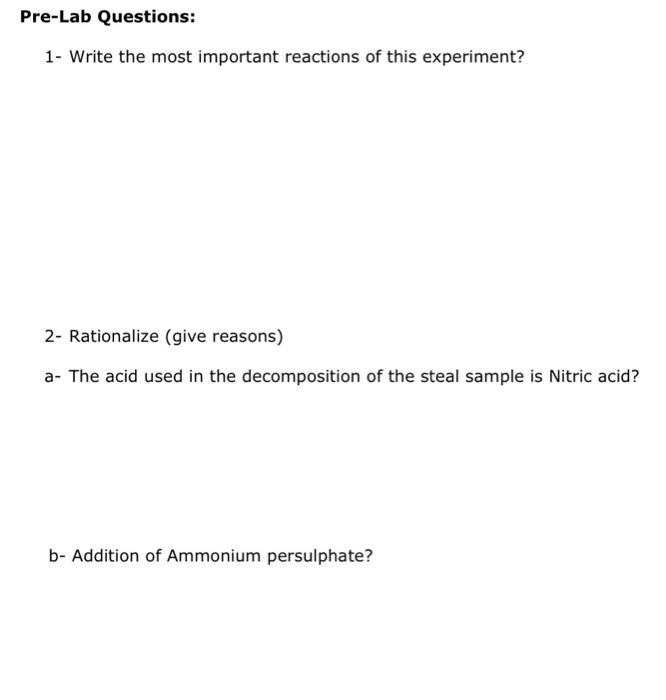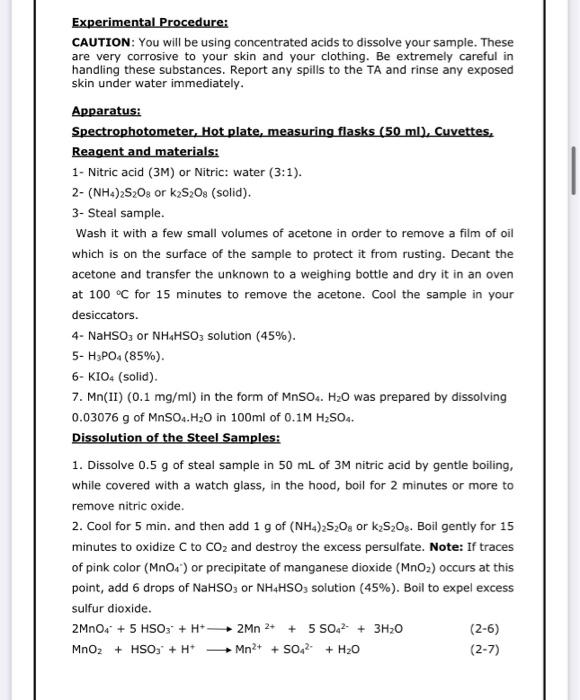the questions are on the first page
Pre-Lab Questions: 1- Write the most important reactions of this experiment? 2- Rationalize (give reasons) a- The acid used in the decomposition of the steal sample is Nitric acid? b- Addition of Ammonium persulphate? EXPERIMENT - 4 Spectrophotometric Determination of Manganese in Steel with standard addition method. Theory: Steel is an alloy of iron and Mn and other elements. Manganese in steel is determined by dissolving the steel and oxidizing the resulting Manganese (II) to manganese (VII), which is measured spectrophotometrically. Three oxidizing agents are used: The steel is first dissolved in dilute nitric acid to form iron (III) and manganese (II) (Equation 3-2). During the dissolution, NO and NO2 are produced, these may interfere later in the experiment by reducing periodic acid; hence, they are partially removed by boiling, interference by Fe (III) minimized by adding H3PO4 to form a nearly colorless complex with Fe (III). Ammonium persulfate is used as an auxiliary oxidant, to oxidize the remaining oxides of nitrogen (Equation 3-3) and any carbon or other organic material present (Equation 34). Unreacted peroxydisulfate is then decomposed by reducing it with boiling water (Equation 3-5). 3Mn(0)+2NO3++8H+=3Mn2++2NO(g)+4H2O2NO2+S2O82+2H2O=2NO3+2SO42++4H+[reagent:(NH4)2S2O8]C(S)+2S2O82++2H2OCO2+4SO42+4H+.(22)2S2O82++2H2O=4SO42++O2(g)+4H Theoretically, peroxydisulfate has the oxidizing potential to oxidize manganese (II) to Manganese (VII), but the reaction is kinetically too slow to be useful. Potassium periodate oxidizes manganese (II) to manganese (VII) more rapidly and reproducibly and is preferred for the oxidation (Equation 3-1). The oxidation is carried out at the boiling point, to speed up the reaction and increase the solubility of the sparingly soluble potassium periodate. Since periodate also decomposes slightly at these temperatures, it is a good technique to add it in two portions to maintain an excess. Experimental Procedure: CAUTION: You will be using concentrated acids to dissolve your sample. These are very corrosive to your skin and your clothing. Be extremely careful in handling these substances. Report any spills to the TA and rinse any exposed skin under water immediately. Apparatus: Spectrophotometer, Hot plate, measuring flasks (50ml ), Cuvettes, Reagent and materials: 1- Nitric acid (3M) or Nitric: water (3:1). 2- (NH4)2S2O3 or k2S2O8 (solid). 3- Steal sample. Wash it with a few small volumes of acetone in order to remove a film of oil which is on the surface of the sample to protect it from rusting. Decant the acetone and transfer the unknown to a weighing bottle and dry it in an oven at 100C for 15 minutes to remove the acetone. Cool the sample in your desiccators. 4- NaHSO3 or NH4HSO3 solution (45\%). 5H3PO4(85%). 6=KIO4 (solid). 7. Mn (II) (0.1mg/ml) in the form of MnSO4. H2O was prepared by dissolving 0.03076g of MnSO4.H2O in 100ml of 0.1MH2SO4. Dissolution of the Steel Samples: 1. Dissolve 0.5g of steal sample in 50mL of 3M nitric acid by gentle boiling, while covered with a watch glass, in the hood, boil for 2 minutes or more to remove nitric oxide. 2. Cool for 5min. and then add 1g of (NH4)2S2O8 or k2S2O8. Boil gently for 15 minutes to oxidize C to CO2 and destroy the excess persulfate. Note: If traces of pink color (MnO4)or precipitate of manganese dioxide (MnO2) occurs at this point, add 6 drops of NaHSO3 or NH4HSO3 solution (45\%). Boil to expel excess sulfur dioxide. 2MnO4+5HSO3+H+2Mn2++5SO42+3H2OMnO2+HSO3+H+Mn2++SO42+H2O The purpose of removing a colored species at this time is that the solution is going to serve as a reagent blank. Dilution: 3. Cool to room temperature and filter (if necessary) into a 250ml volumetric flask through filter paper. Finally, allow the volumetric flask to cool and dilute to the mark with distllled water, and mix well. Oxidation of the Mn2+ : 4. Pipet 25.00ml from the 250ml volumetric flask in step 3 into each of three clean, dry 100ml beakers designated (blank, unknown, and standard addition); add 5mL of 85%H3PO4 into each beaker. Then add standard Mn2+ (0.1mg/ml) and solid KIO4 as follows: 5. Boil the unknown and standard addition beakers gently for 5 minutes to oxidize Mn2+ to MnO4. Continue boiling, if necessary, until the KIO4 dissolves. 6. Cool and transfer the two samples quantitatively to a labeled 50mL volumetric flask and dilute to volume, mixing thoroughly. Measurements and data analysis: 7. After zeroing the instrument with a reagent blank at 525nm, fill the sample cell with a solution of your unknown and then with the standard addition and record the absorbance of both. 8. From the known concentration of the Mn standard, calculate the concentration of added Mn in the 50ml volumetric flask containing the standard addition. 9. From the difference between the absorbance of the standard addition and the unknown, calculate the molar absorptivity of MnO4 :. 10. From the absorbance of the unknown and the molar absorptivity of MnO4. , calculate the concentration of Mn in 50ml unknown solution. 32 TWSTRUHENIAL ANALYSIS FOR CHEMICAL ENGINEERING (CMEN 3 FOV) UNITED ARAB EMIRATES UNTVERSITY, CHEMISTRY DERARTMENT 11. Calculate the weight percent manganese in the steel sample and the 95% confidence limits for three samples










